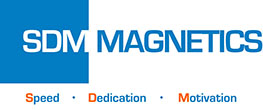Neodymium magnet, also referred as NdFeB magnet or Neo magnet, is the most powerful and commonly used rare earth magnet. It was discovered independently by General Motors and Sumitomo Special Metals in 1984 as they investigated substitutes to the expensive Samarium Cobalt magnet. Neodymium magnets are primary made from an alloy of Neodymium (Nd), Iron (Fe), and Boron (B) to form the Nd2Fe14B main phase which has excellent magnetic properties. In addition, Neodymium resource is comparatively rich. The successful development of Neodymium magnet declared the birth of the third-generation rare earth permanent magnet. Since then, Neodymium magnets are served for nearly all industries.
Classifications of Neodymium Magnets
Neodymium magnets can be divided into sintered Neodymium magnets, hot pressed Neodymium magnets, and bonded Neodymium magnets base on the manufacturing process. Sintered, hot pressed, and bonded form each has their distinctive magnetic performance. Their overlapped application scope is less and under a complementary relationship.
Sintered Neodymium Magnets
Sintered Neodymium magnets are produced by conventional powder metallurgy process. It still offers the strongest magnetic power nowadays and occupies an absolute predominance in the market share.
Hot Pressed Neodymium Magnets
Hot pressed Neodymium magnets are an ideal solution to manufacture radially oriented ring magnet. Hot pressed Neodymium magnet can fulfill the performance gap between bonded Neodymium magnet and sintered Neodymium magnet. Hot pressed Neodymium magnet exhibit superior corrosion resistance due to inherent nanocrystalline structure, lower Nd-rich phase content, and higher density.
Bonded Neodymium Magnets
Bonded Neodymium magnets are a type of composite material which composed of NdFeB powder and binder. Bonded Neodymium magnets can be further divided into compression molded Neodymium magnets and injection molded Neodymium magnets on the basis of binder type and molding process. Bonded Neodymium magnets are well-known for the complex shape, high dimensional precision, tight tolerance, integration capability with other functional parts, and mass production capacity.
Influencing Factors of Neodymium Magnet Price
As the most important raw material of Neodymium magnet, PrNd mischmetal occupies the largest proportion of the total cost. Price fluctuation of PrNd mischmetal has the most significantly impact on the Neodymium magnet cost. In addition to PrNd price, cost of high-coercivity sintered Neodymium magnets is also affected by the price and amount of heavy rare earth elements (HREEs). Sintered Neodymium magnets are generally adopting HREEs Dysprosium (Dy) and Terbium (Tb) to adjust intrinsic coercivity, but the cost will also sharply be increasing simultaneously. Dy and Tb are typically used in the form of DyFe alloy and Tb metal. Unlike sintered Neodymium magnets, either bonded Neodymium magnets or hot-pressed Neodymium magnets is not necessary to utilize HREEs to enhance intrinsic coercivity and temperature stability.



